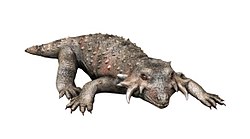Mesozoic
- † Acanthichnus
- † Anchisauripus
- † Anchisauripus exsertus
- † Anchisauripus giganteus – type locality for species
- † Anchisauripus hitchcocki
- † Anchisauripus parallelus
- † Anchisauripus sillimani
- † Anchisauripus tuberosus

Restoration of the Early Jurassic sauropodomorph dinosaur Anchisaurus - † Anchisaurus polyzelus – type locality for species
- † Ancyropus – type locality for genus
- † Ancyropus heteroclitus – type locality for species
- † Anomoepus
- † Argoides
- † Argoides macrodactylus – type locality for species
- † Argoides minimus – type locality for species
- † Baiera
- † Batrachopus
- † Belodon
- † Belodon validus – type locality for species
- † Bisulcus
- Botryopera
- † Brontozoum
- † Cochlichnus
- † Coelophysis
- † Conopsoides
- † Corvipes
- † Cunichoides
- † Cunichoides marsupialoideus – type locality for species
- † Cunicularius
- † Erpetosuchus
Fossil Eubrontes tracks. Eubrontes is the Connecticut state fossil. - † Eubrontes approximatus
- † Eubrontes dananus – type locality for species
- † Eubrontes divaricatus
- † Eubrontes giganteus
- † Gigandipus
- † Grallator
- † Harpedactylus
- † Harpedactylus tenuissimus – type locality for species
- † Herpystezoum
- † Holcoptera
- † Hoplichnus

Life restoration of Hypsognathus . - † Isocampe
- † Loperia
- † Mormolucoides
- † Ornithoidichnites
- † Ornithoidichnites gracillior – type locality for species
- † Ornithoidichnites sillimani – type locality for species

Fossil from Dinosaur State Park and Arboretum of the Late Triassic-Middle Jurassic sauropodomorph dinosaur footprint ichnogenus Otozoum - † Palamopus
- † Platypterna
- † Platypterna deanii – type locality for species
- † Platypterna delicatula – type locality for species
- † Platypterna tenuis – type locality for species
- † Plectropterna
- † Plectropus
- † Plesiornis
- † Redfieldius

Fossilized skeleton of the Late Triassic-Early Jurassic bony fish Semionotus - † Sillimanius
- † Sillimanius gracilior – type locality for species
- † Sillimanius tetradactylus – type locality for species
- † Stegomus – type locality for genus
- † Stegomus arcuatus – type locality for species
- † Steropoides
- † Tarsoplectrus
- † Tarsoplectrus elegans – type locality for species
- † Triaenopus
- † Triaenopus baileyanus – type locality for species
- † Triaenopus lulli – type locality for species
- † Trihamus
- † Typopus
- † Typopus gracilis – type locality for species




